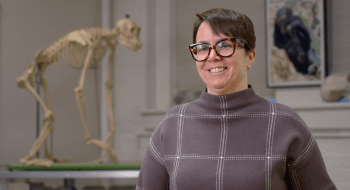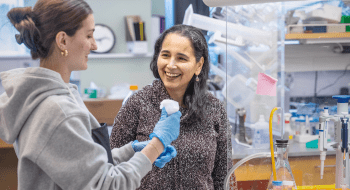
Understanding the Overlap of Urban and Agriculture
Georgia Grzywacz's work highlights the relationship of agriculture and the urban
Georgia Grzywacz ’20 began her agricultural internship doing the typical early-morning prep work. She prechopped the day’s compost, organized the seeds that had to be planted, and made sure to take extra care while feeding the chickens that were running around inside their coop (her favorite part of the day).
It is easy to imagine Grzywacz’s internship in rural fields of northern New York, but Grzywacz wasn’t just surrounded by bird feed and vegetable seeds: instead, she was surrounded by the sounds of New York City bustling through its early morning rush. Grzywacz was in the heart of Upper Manhattan, working with an urban agricultural organization called Harlem Grown.
It all began in her first year at Cornell University, before Grzywacz transferred to St. Lawrence. She was just coming off a summer at Muscoot Farm, a historical education farm in her hometown of Cross River, New York. She was interested in combining the fields of education and environmental studies and found a summer internship with Harlem Grown, an organization focused on educating communities across Harlem on the importance of sustainable urban agriculture.
“We ended up spending our spring break assisting Harlem Grown in the establishment of their ‘Tot Lot,’ a garden plot specifically designated for younger learners,” Grzywacz says. “We helped clear the site, create the garden plan, and construct a number of interactive tools to help the kids learn about urban agriculture while also engaging their five senses.”
Grzywacz admits that the enthusiasm that the Harlem community had for their tours and educational sessions was contagious.
The local kids particularly enjoyed working with Grzywacz, chopping up the compost and learning about the importance of the worms throughout the process while being able to hold them in their own hands. Grzywacz believes it’s this early-stage curiosity that can set the next generation on a path in urban agriculture as a sustainable alternative to current food sources.
“I began to recognize the role urban agriculture can play in not only adapting to climate change, but also fostering community and economic development,” Grzywacz says. “It was clear that most hadn’t been exposed to a farm before and didn’t realize one could exist in the city, so their excitement was so heartwarming and amazing to see.”
While the work that Grzywacz was doing with Harlem Grown was impactful, it didn’t come without challenges and self-reflection.
“I struggled with the inherent contradiction of my internship,” Grzywacz explains. “Harlem Grown is a community-based organization, and I grew up far from this community.” Reflecting on her experience as a white, upper-middle-class woman from a town of 1,246 people, and learning about the experiences of the community that Harlem Grown serves, Grzywacz realized she could build relationships with the kids based on a shared passion for earthworms and chickens, as well as a shared goal of creating sustainable living for every community.
Grzywacz’s work with Harlem Grown has inspired her to work in the nonprofit sector, to combine the fields of agriculture and education, and to continue fostering sustainable development in low-income communities. At St. Lawrence, she is able to combine majors in environmental studies and sociology to inform her future in
this arena.
“I want to learn more about the intersection of humans and their environment, as well as more specific issues such as food justice and environmental racism.” Grzywacz says. “My work with Harlem Grown has inspired my desire to do that.”




